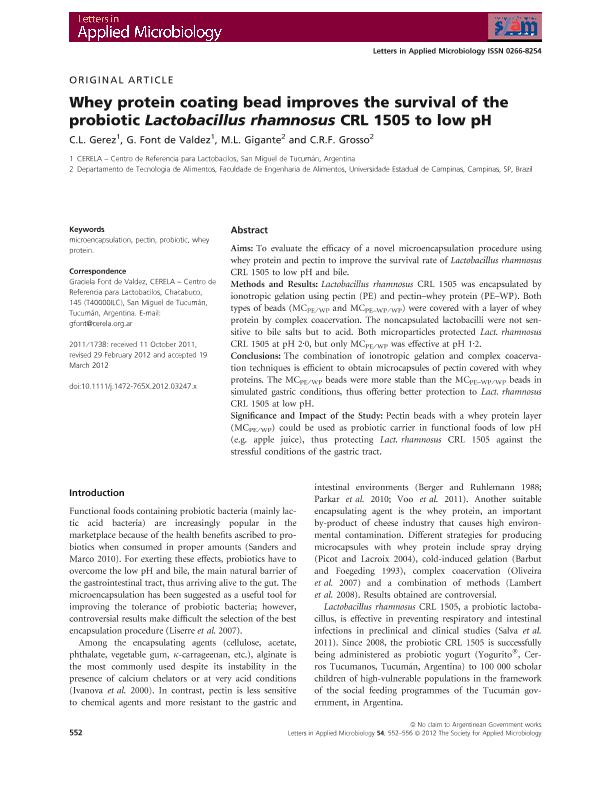Mostrar el registro sencillo del ítem
dc.contributor.author
Gerez, Carla Luciana

dc.contributor.author
Font, Graciela Maria

dc.contributor.author
Gigante, Mirna L.
dc.contributor.author
Grosso, Carlos
dc.date.available
2017-09-25T15:18:30Z
dc.date.issued
2012-04
dc.identifier.citation
Gerez, Carla Luciana; Font, Graciela Maria; Gigante, Mirna L.; Grosso, Carlos; Whey protein coating bead improves the survival of the probiotic Lactobacillus rhamnosus CRL 1505 to low pH; Wiley; Letters In Applied Microbiology; 54; 6; 4-2012; 552-556
dc.identifier.issn
0266-8254
dc.identifier.uri
http://hdl.handle.net/11336/25037
dc.description.abstract
Aims: To evaluate the efficacy of a novel microencapsulation procedure using whey protein and pectin to improve the survival rate of Lactobacillus rhamnosus CRL 1505 to low pH and bile.
Methods and Results: Lactobacillus rhamnosus CRL 1505 was encapsulated by ionotropic gelation using pectin (PE) and pectin–whey protein (PE–WP). Both types of beads (MCPE/WP and MCPE–WP/WP) were covered with a layer of whey protein by complex coacervation. The noncapsulated lactobacilli were not sensitive to bile salts but to acid. Both microparticles protected Lact. rhamnosus CRL 1505 at pH 2·0, but only MCPE/WP was effective at pH 1·2.
Conclusions: The combination of ionotropic gelation and complex coacervation techniques is efficient to obtain microcapsules of pectin covered with whey proteins. The MCPE/WP beads were more stable than the MCPE–WP/WP beads in simulated gastric conditions, thus offering better protection to Lact. rhamnosus CRL 1505 at low pH.
Significance and Impact of the Study: Pectin beads with a whey protein layer (MCPE/WP) could be used as probiotic carrier in functional foods of low pH (e.g. apple juice), thus protecting Lact. rhamnosus CRL 1505 against the stressful conditions of the gastric tract.
dc.format
application/pdf
dc.language.iso
eng
dc.publisher
Wiley

dc.rights
info:eu-repo/semantics/openAccess
dc.rights.uri
https://creativecommons.org/licenses/by-nc-sa/2.5/ar/
dc.subject
Lactobacillus Rhamnosus
dc.subject
Whey Protein
dc.subject
Microencapsulation
dc.subject
Pectin
dc.subject
Probiotic
dc.subject.classification
Alimentos y Bebidas

dc.subject.classification
Otras Ingenierías y Tecnologías

dc.subject.classification
INGENIERÍAS Y TECNOLOGÍAS

dc.title
Whey protein coating bead improves the survival of the probiotic Lactobacillus rhamnosus CRL 1505 to low pH
dc.type
info:eu-repo/semantics/article
dc.type
info:ar-repo/semantics/artículo
dc.type
info:eu-repo/semantics/publishedVersion
dc.date.updated
2017-07-26T15:25:43Z
dc.identifier.eissn
1472-765X
dc.journal.volume
54
dc.journal.number
6
dc.journal.pagination
552-556
dc.journal.pais
Reino Unido

dc.journal.ciudad
Oxford
dc.description.fil
Fil: Gerez, Carla Luciana. Consejo Nacional de Investigaciones Científicas y Técnicas. Centro Científico Tecnológico Conicet - Tucumán. Centro de Referencia para Lactobacilos; Argentina
dc.description.fil
Fil: Font, Graciela Maria. Consejo Nacional de Investigaciones Científicas y Técnicas. Centro Científico Tecnológico Conicet - Tucumán. Centro de Referencia para Lactobacilos; Argentina
dc.description.fil
Fil: Gigante, Mirna L.. Universidade Estadual de Campinas; Brasil
dc.description.fil
Fil: Grosso, Carlos. Universidade Estadual de Campinas; Brasil
dc.journal.title
Letters In Applied Microbiology

dc.relation.alternativeid
info:eu-repo/semantics/altIdentifier/doi/http://dx.doi.org/10.1111/j.1472-765X.2012.03247.x
dc.relation.alternativeid
info:eu-repo/semantics/altIdentifier/url/http://onlinelibrary.wiley.com/doi/10.1111/j.1472-765X.2012.03247.x
Archivos asociados
